Delay and Energy Efficient Offloading Strategies for an IoT Integrated Water Distribution System in Smart Cities
Abstract
1. Introduction
- Identified the different challenges of a WDN in a secondary metropolitan city and designed communication network entities and topologies.
- Development of wireless propagation model for a specific study area depending upon the land use land cover pattern, network reliability, channel, and communication parameters and assumed that external climatic factors do not affect the communication network.
- Integrated delay and energy analysis for the designed wireless channel model for an IoT-based communication architecture for WDN in secondary metropolitan cities.
- Node categorization and node allocation algorithm with integrated delay and energy-efficient offloading for IoT-based communication architecture for WDN in secondary metropolitan cities.
- Numerical analysis for the proposed algorithm incorporating the delay and energy-efficient offloading scenarios are included.
2. Design Considerations for an IoT-Enabled WDN
2.1. Water Supply-Consumption Imbalance
2.2. Sub-Optimal Faults from the Operator Side
2.3. Water Quality Analysis
2.4. Pipe Line Water Theft Detection
2.5. Automatic Fault Pipe Detection
2.6. Automatic Billing System
2.7. Optimised Water Distribution
3. IoT-Enabled Water Distribution Network
- PMS: The pressure sensors are deployed underground beneath the pipe to continuously monitor water pressure.
- FMS: The flow sensors are also deployed underground beneath the pipe to continuously monitor water pressure.
- LMS: The level sensors are deployed in the water tanks in the main water collection point to know the quantity of water available in the tank.
- QMS: QMS consists of sensors for water quality monitoring. Various water quality parameters such as pH, iron, fluoride, and calcium content in water can be monitored by deploying the corresponding sensors in the locations or water outlets.
3.1. Edge Node
3.2. Fog Node
3.3. Cloud Server
4. Case Study: Designing of IoT-Enabled Water Distribution Network in the Study Area
4.1. Study Area
4.2. Site Specific Propagation Model Selection Criteria
4.3. Delay-Efficient Offloading in IoT-Enabled WDN
- the time taken to push the data bits/packets to the receiver. It depends on the transmission channel to the to the , channel bandwidth B, size of the data. The delay depends on the transmission rate , the message length M, and the channel access delay [40]
- is the processing delay depending on the characteristics parameters of the such as fog memory, clock frequency altogether termed as fog processing capacity
- is negligible as the data in this water network is not higher. This will be our enhanced future work.
4.3.1. Delay Modelling
4.3.2. Packet Flow and Delay-Efficient Offloaded WDN Architecture
4.4. Energy Offloading for IoT-Enabled WDN
- : Operation state in which the IoT node is powered. It is the state with minimum power consumption.
- : Operation state in which the IoT node is not powered.
- : Operation state in which the IoT node is in a temporary state, even if the node is powered . The power consumption is the least in this state.
- : Operation state in which the IoT sensors are working - collecting the data from different sensors.
- : Operation state in which the IoT computations and processing are taking place after the sensor data collection.
- : Operation state in which the IoT sensor collected data are processed and stored in the memory unit.
- : Operation state in which transmission is taking place. The radio is ON, and the antennas are active.
- : Operation state in which reception is taking place. The radio is ON, and the antennas are active.
4.4.1. Operational Strategy 1
4.4.2. Operational Strategy 2
5. Algorithms Performed in the Communication Architecture
- To categorize the random node to edge, fog or miscellaneous category
- To allocate an edge node to a fog node for hierarchical communication
5.1. Node Categorizing Algorithm
5.2. Node Allocation Algorithm
| Algorithm 1 Node categorizing algorithm based on offloading |
Input: CandidateNode - Random Node Output: Categorize the random node into EdgeNode, FogNode or MiscellaneousNode
|
| Algorithm 2 Edge Node to Fog allocation algorithm |
Input: EdgeNode Output: FogNode
|
6. Numerical Analysis and Discussions
6.1. Delay-Efficient Offloading
6.2. Energy-Efficient Offloading
6.2.1. Strategy 1
6.2.2. Strategy 2
7. Results and Discussions
8. Conclusions
Author Contributions
Funding
Institutional Review Board Statement
Informed Consent Statement
Data Availability Statement
Acknowledgments
Conflicts of Interest
Abbreviations
| IoT | Internet of Things |
| ICT | Information and Communications Technology |
| M2M | Machine-to-Machine |
| WDS | Water Distribution System |
| WTP | Water Treatment Pant |
| PMS | pressure monitoring sensor |
| PMS | Pressure monitoring Sensor |
| LMS | Flow monitoring sensor |
| FMS | Flow Monitoring Sensor |
| QMS | Quality Monitoring Sensors |
| QGIS | Quantum Geographic Information System |
| SCP | Semi-Automatic Classification |
| MLC | Maximum Likelihood Supervised Classification |
| LULC | and Use Land Cover |
| FSTL | Free-Space Transmission Loss |
| Received power | |
| Transmitted power | |
| Gain of transmitting antenna | |
| Gain of receiving antenna | |
| wavelength | |
| d | Distance between transmitting and receiving antennas |
| L | Transmission loss |
| Distance on Kilometer | |
| Path loss in Urban areas | |
| Height of base station antenna (m) | |
| Height of mobile antenna (m) | |
| f | Frequency of transmission (MHz) |
| Antenna height correction factor (dB) | |
| Spectral efficiency of the wireless link of the edge device | |
| Product of losses in the wireless channel | |
| Edge node | |
| Fog node | |
| Received power at the fog node | |
| Noise power spectral density | |
| Transmission power required from the edge node to fog node through the link j | |
| Received power at the fog node | |
| SIR threshold | |
| Total delay | |
| Propagation delay | |
| Transmission delay | |
| Processing delay | |
| Queuing delay | |
| B | Channel bandwidth |
| Transmission channel to the to the | |
| Size of the data | |
| Transmission rate | |
| M | Message length |
| The channel access delay | |
| Fog memory | |
| Clock frequency | |
| Fog processing capacity | |
| The constant delay parameter for the propagation delay | |
| The total delay in the communication network of a single node | |
| The sensing delay of a single node | |
| The processing delay of a single node | |
| The transmission delay of a single node | |
| The channel delay | |
| the delay due to bandwidth issues | |
| the delay due to propagation effects | |
| the total number of edge devices | |
| The total capacity of the cloud server | |
| The total number of fog devices | |
| cloud server capacity | |
| Data rate of each edge node | |
| , , ... | The intermediate fog nodes |
| , ,... | The data rates of the intermediate nodes |
| The edge and fog devices are in ON state and the transmission and reception are taking place every second | |
| The power consumption state | |
| The energy consumption state | |
| Sensing time | |
| Sensing energy | |
| Sensing power | |
| Computation energy | |
| computation power | |
| Computation time | |
| Transmit/Receive energy | |
| Transmit/Receive power | |
| Transmit/Receive time | |
| The total energy consumption of the edge | |
| The total energy consumption of the fog | |
| Sleep energy | |
| Sleep power | |
| Sleep time | |
| Storage energy | |
| Storage power | |
| Storage time |
References
- Loucks, D.P.; Beek, E.v. Water resources planning and management: An overview. In Water Resource Systems Planning and Management; Springer: Cham, Switzerland, 2017; pp. 1–49. [Google Scholar]
- Brentan, B.; Meirelles, G.; Luvizotto, E., Jr.; Izquierdo, J. Hybrid SOM+ k-Means clustering to improve planning, operation and management in water distribution systems. Environ. Model. Softw. 2018, 106, 77–88. [Google Scholar] [CrossRef]
- Rathore, M.M.; Ahmad, A.; Paul, A.; Rho, S. Urban planning and building smart cities based on the internet of things using big data analytics. Comput. Netw. 2016, 101, 63–80. [Google Scholar] [CrossRef]
- Cosgrove, W.J.; Loucks, D.P. Water management: Current and future challenges and research directions. Water Resour. Res. 2015, 51, 4823–4839. [Google Scholar] [CrossRef]
- Chettri, L.; Bera, R. A comprehensive survey on Internet of Things (IoT) toward 5G wireless systems. IEEE Internet Things J. 2019, 7, 16–32. [Google Scholar] [CrossRef]
- Mehmood, Y.; Ahmad, F.; Yaqoob, I.; Adnane, A.; Imran, M.; Guizani, S. Internet-of-things-based smart cities: Recent advances and challenges. IEEE Commun. Mag. 2017, 55, 16–24. [Google Scholar] [CrossRef]
- Velayudhan, N.K.; Pradeep, P.; Rao, S.N.; Devidas, A.R.; Ramesh, M.V. IoT-enabled water distribution systems—A comparative technological review. IEEE Access 2022, 10, 101042–101070. [Google Scholar] [CrossRef]
- Laya, A.; Wang, K.; Widaa, A.A.; Alonso-Zarate, J.; Markendahl, J.; Alonso, L. Device-to-device communications and small cells: Enabling spectrum reuse for dense networks. IEEE Wirel. Commun. 2014, 21, 98–105. [Google Scholar] [CrossRef]
- Sharma, S.K.; Wang, X. Live data analytics with collaborative edge and cloud processing in wireless IoT networks. IEEE Access 2017, 5, 4621–4635. [Google Scholar] [CrossRef]
- Firouzi, F.; Farahani, B.; Marinšek, A. The convergence and interplay of edge, fog, and cloud in the AI-driven Internet of Things (IoT). Inf. Syst. 2022, 107, 101840. [Google Scholar] [CrossRef]
- Venkatesan, V.K.; Izonin, I.; Periyasamy, J.; Indirajithu, A.; Batyuk, A.; Ramakrishna, M.T. Incorporation of Energy Efficient Computational Strategies for Clustering and Routing in Heterogeneous Networks of Smart City. Energies 2022, 15, 7524. [Google Scholar] [CrossRef]
- Mavromoustakis, C.X.; Mukherjee, M.; Mastorakis, G.; Song, H.; Gorlatova, M.; Aazam, M. Guest Editorial Special Issue on Emerging Trends and Challenges in Fog Computing for IoT. IEEE Internet Things J. 2020, 7, 4155–4159. [Google Scholar] [CrossRef]
- Minoli, D.; Sohraby, K.; Occhiogrosso, B. IoT considerations, requirements, and architectures for smart buildings—Energy optimization and next-generation building management systems. IEEE Internet Things J. 2017, 4, 269–283. [Google Scholar] [CrossRef]
- Soundararajan, R.; Stanislaus, P.M.; Ramasamy, S.G.; Dhabliya, D.; Deshpande, V.; Sehar, S.; Bavirisetti, D.P. Multi-channel assessment policies for energy-efficient data transmission in wireless underground sensor networks. Energies 2023, 16, 2285. [Google Scholar] [CrossRef]
- Bagchi, S.; Abdelzaher, T.F.; Govindan, R.; Shenoy, P.; Atrey, A.; Ghosh, P.; Xu, R. New frontiers in IoT: Networking, systems, reliability, and security challenges. IEEE Internet Things J. 2020, 7, 11330–11346. [Google Scholar] [CrossRef]
- Naseer, S.; Liu, W.; Sarkar, N.I. Energy-efficient massive data dissemination through vehicle mobility in smart cities. Sensors 2019, 19, 4735. [Google Scholar] [CrossRef]
- Vinayakumar, R.; Alazab, M.; Srinivasan, S.; Pham, Q.V.; Padannayil, S.K.; Simran, K. A visualized botnet detection system based deep learning for the internet of things networks of smart cities. IEEE Trans. Ind. Appl. 2020, 56, 4436–4456. [Google Scholar] [CrossRef]
- Adedeji, K.B.; Ponnle, A.A.; Abu-Mahfouz, A.M.; Kurien, A.M. Towards digitalization of water supply systems for sustainable smart city development—Water 4.0. Appl. Sci. 2022, 12, 9174. [Google Scholar] [CrossRef]
- Rojek, I.; Studzinski, J. Detection and localization of water leaks in water nets supported by an ICT system with artificial intelligence methods as a way forward for smart cities. Sustainability 2019, 11, 518. [Google Scholar] [CrossRef]
- Kumari, M.S.; Kumar, N. Channel model for simultaneous backhaul and access for mmWave 5G outdoor street canyon channel. Wirel. Netw. 2020, 26, 5997–6013. [Google Scholar] [CrossRef]
- Anagnostopoulos, C.; Aladwani, T.; Alghamdi, I.; Kolomvatsos, K. Data-driven analytics task management reasoning mechanism in edge computing. Smart Cities 2022, 5, 562–582. [Google Scholar] [CrossRef]
- Ann, J.D.; Sujith, K. Addressing walkability of Kochi corporation area with a focus on inland water transportation. In Proceedings of the IOP Conference Series: Materials Science and Engineering, Kerala, India, 17–19 December 2020; IOP Publishing: Bristol, UK, 2021; Volume 1114, p. 012036. [Google Scholar]
- Kuriakose, P.N.; Philip, S. City profile: Kochi, city region-Planning measures to make Kochi smart and creative. Cities 2021, 118, 103307. [Google Scholar] [CrossRef]
- Adithya, K.; Ajith, V.; Nibi, K.; Ramesh, M.V. Design of IoT and ML enabled Framework for Water Quality Monitoring. In Proceedings of the 2022 3rd International Conference on Electronics and Sustainable Communication Systems (ICESC), Coimbatore, India, 17–19 August 2022; IEEE: Piscataway, NJ, USA, 2022; pp. 452–460. [Google Scholar]
- Nibi, K.; Kumar, M.N.; Devidas, A.R.; Ramesh, M.V.; Thadathil, S.P. GIS based Urban Water Distribution Network Analysis: A Case Study in Kochi, India. In Proceedings of the 2022 International Conference on Computing, Communication, and Intelligent Systems (ICCCIS), Greater Noida, India, 4–5 November 2022; IEEE: Piscataway, NJ, USA, 2022; pp. 956–963. [Google Scholar]
- Richter, R.; Weingart, U.; Wever, T.; Kahny, U. Urban land use data for the telecommunications industry. Photogramm. Fernerkund. Geoinf. 2006, 2006, 297. [Google Scholar]
- Ali, S.; George, A. Redressing urban isolation: A multi-city case study in India. J. Urban Manag. 2022, 11, 338–352. [Google Scholar] [CrossRef]
- Armoogum, V.; Soyjaudah, K.; Mohamudally, N.; Fogarty, T. Propagation Models and Their Applications in Digital Television Broadcast Network Design and Implementation; IntechOpen: London, UK, 2010. [Google Scholar]
- Friis, H.T. A note on a simple transmission formula. Proc. IRE 1946, 34, 254–256. [Google Scholar] [CrossRef]
- Supanakoon, P.; Aroonpraparat, S.; Promwong, S.; Ichi, J. Free Space Path Loss of UWB Communications; Tokyo Institute of Technology: Tokyo, Japan, 2011; pp. 1–6. [Google Scholar]
- Singh, D.; Jain, A.; Yadav, R.P. Development of circular loop frequency selective surface using 3-d printing technique. Prog. Electromagn. Res. M 2020, 90, 195–203. [Google Scholar] [CrossRef]
- Mourad, F. Investigation on LTE for Advanced Real Time Two Way Communication for Railway Operational Excellence: Case of Addis Ababa–Djibouti Line. Ph.D. Thesis, Addis Ababa University, Addis Ababa, Ethiopia, 2016. [Google Scholar]
- Hata, M. Empirical formula for propagation loss in land mobile radio services. IEEE Trans. Veh. Technol. 1980, 29, 317–325. [Google Scholar] [CrossRef]
- VE2DBE. VE2DBE-Radio Mobile Web Site. 2018. Available online: https://www.ve2dbe.com/rmonline_s.asp (accessed on 1 July 2023).
- Singh, Y. Comparison of okumura, hata and cost-231 models on the basis of path loss and signal strength. Int. J. Comput. Appl. 2012, 59, 37–41. [Google Scholar] [CrossRef]
- Cheng, X.; Guan, J.; Chao, K. A WCDMA propagation model based on COST-231-Walfish-Ikegami pattern for typical residential area. In Proceedings of the 2012 8th International Conference on Wireless Communications, Networking and Mobile Computing, Shanghai, China, 21–23 September 2012; IEEE: Piscataway, NJ, USA, 2012; pp. 1–3. [Google Scholar]
- Milanovic, J.; Rimac-Drlje, S.; Bejuk, K. Comparison of propagation models accuracy for WiMAX on 3.5 GHz. In Proceedings of the 2007 14th IEEE International Conference on Electronics, Circuits and Systems, Marrakech, Morocco, 11–14 December 2007; IEEE: Piscataway, NJ, USA, 2007; pp. 111–114. [Google Scholar]
- Abbasi, M.; Mohammadi-Pasand, E.; Khosravi, M.R. Intelligent workload allocation in IoT–Fog–cloud architecture towards mobile edge computing. Comput. Commun. 2021, 169, 71–80. [Google Scholar] [CrossRef]
- Berger, U. Microwave Communications. In Encyclopedia of Physical Science and Technology, 3rd ed.; Meyers, R.A., Ed.; Academic Press: New York, NY, USA, 2003; pp. 777–798. [Google Scholar] [CrossRef]
- Cabrera, G.J.A.; Fitzek, F.H.; Hanisch, S.; Itting, S.A.; Zhang, J.; Zimmermann, S.; Strufe, T.; Simsek, M.; Fetzer, C.W. Chapter 6—Intelligent networks. In Tactile Internet; Fitzek, F.H., Li, S.C., Speidel, S., Strufe, T., Simsek, M., Reisslein, M., Eds.; Academic Press: Cambridge, MA, USA, 2021; pp. 131–149. [Google Scholar] [CrossRef]
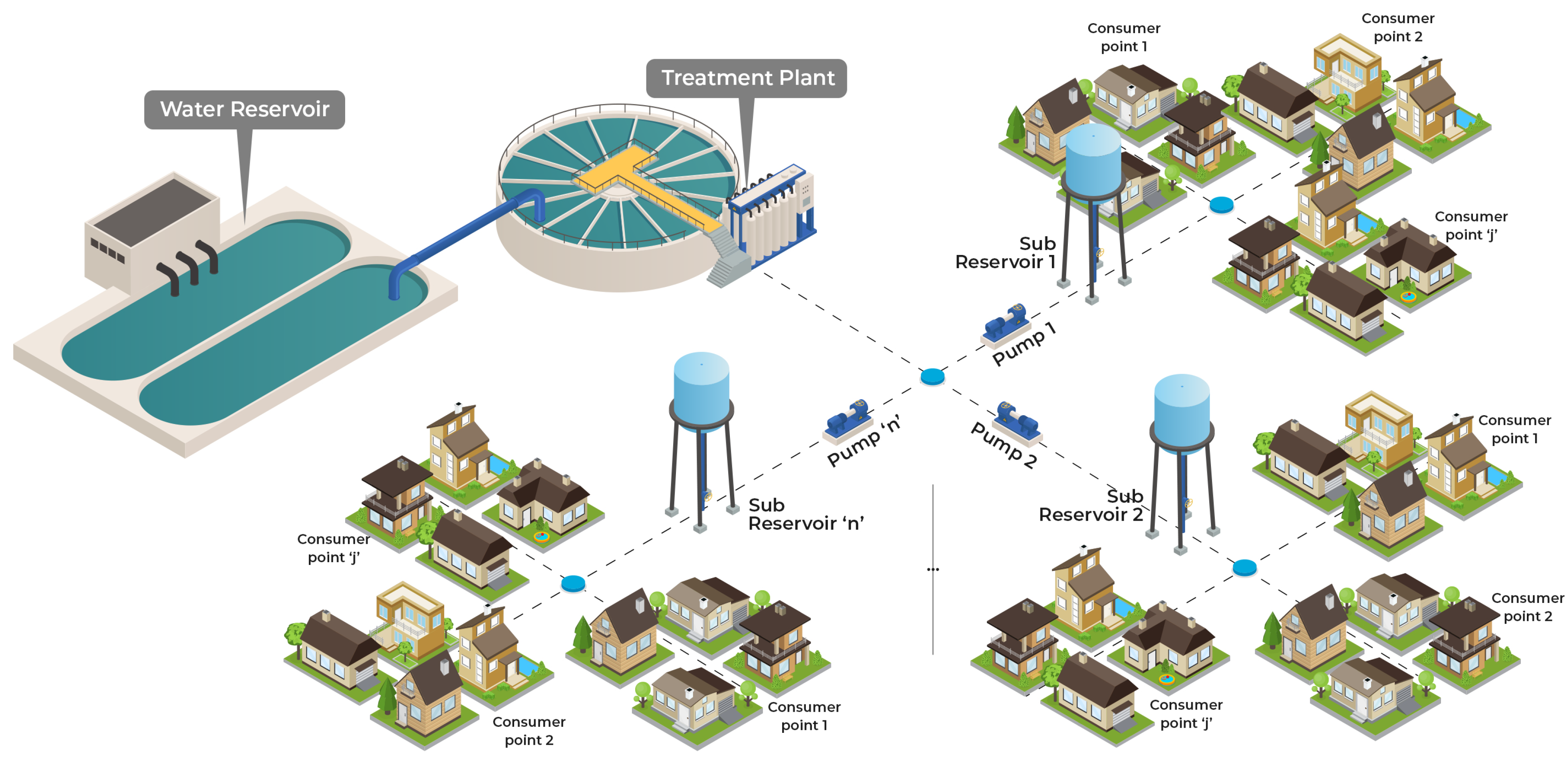

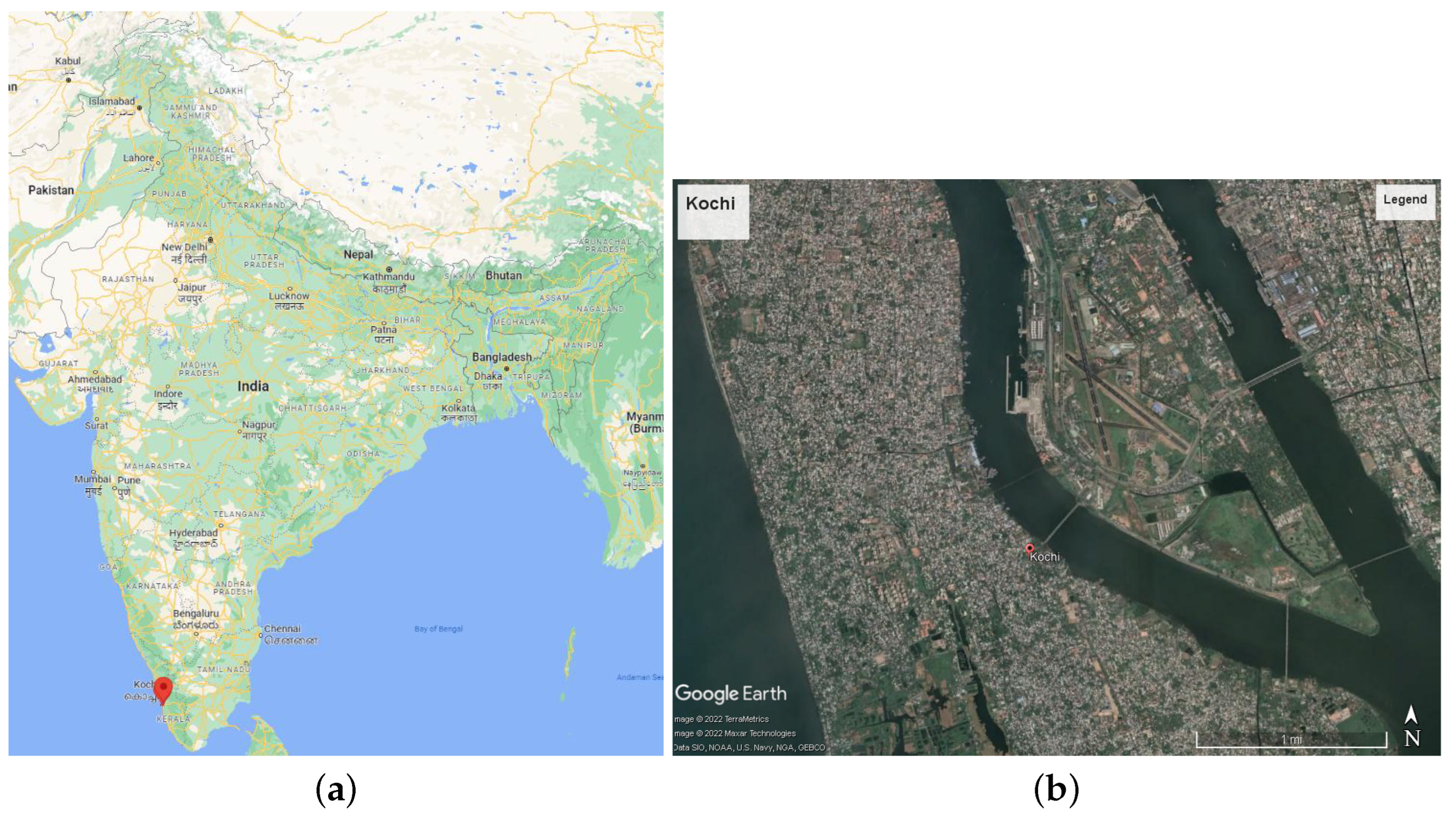


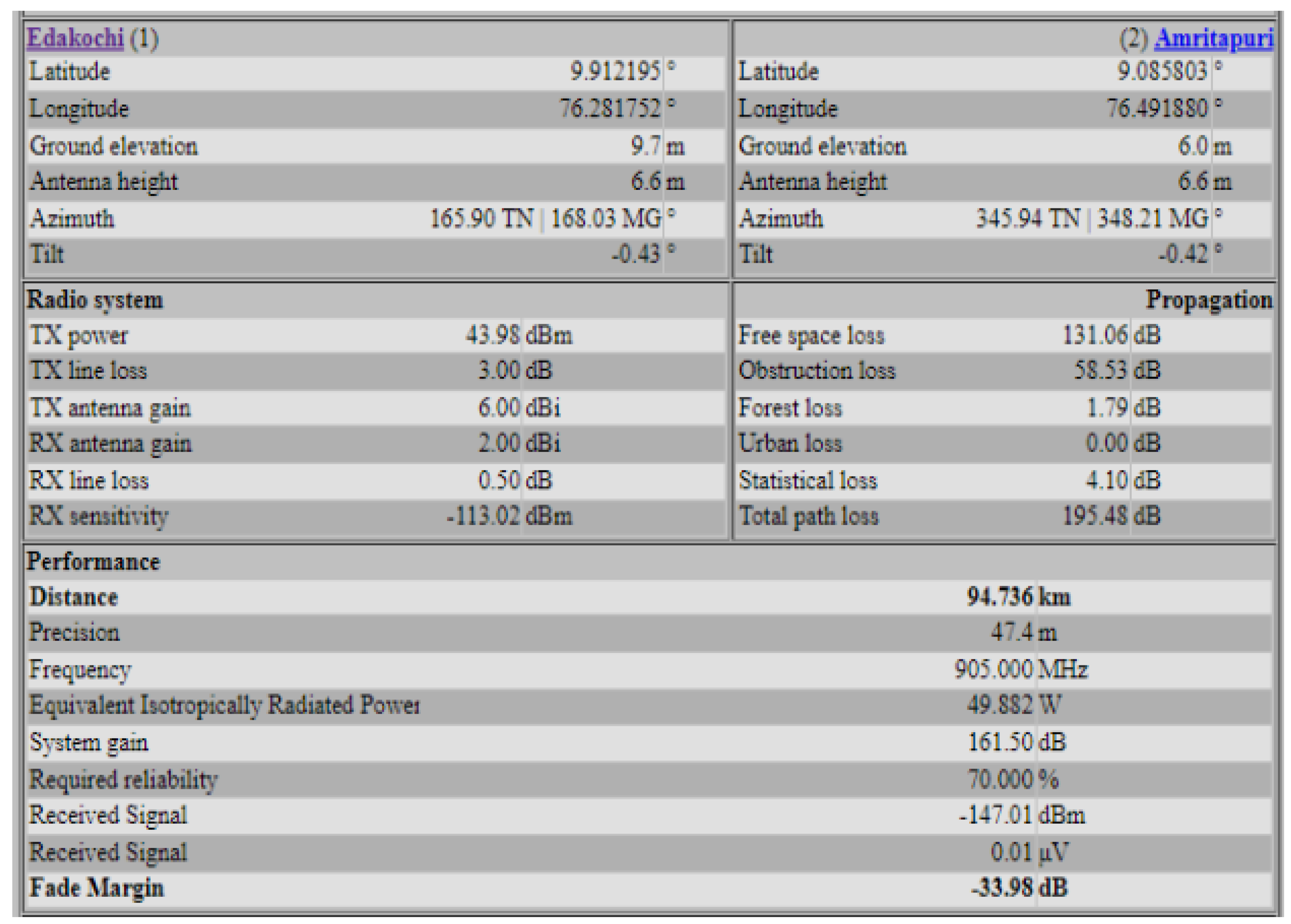

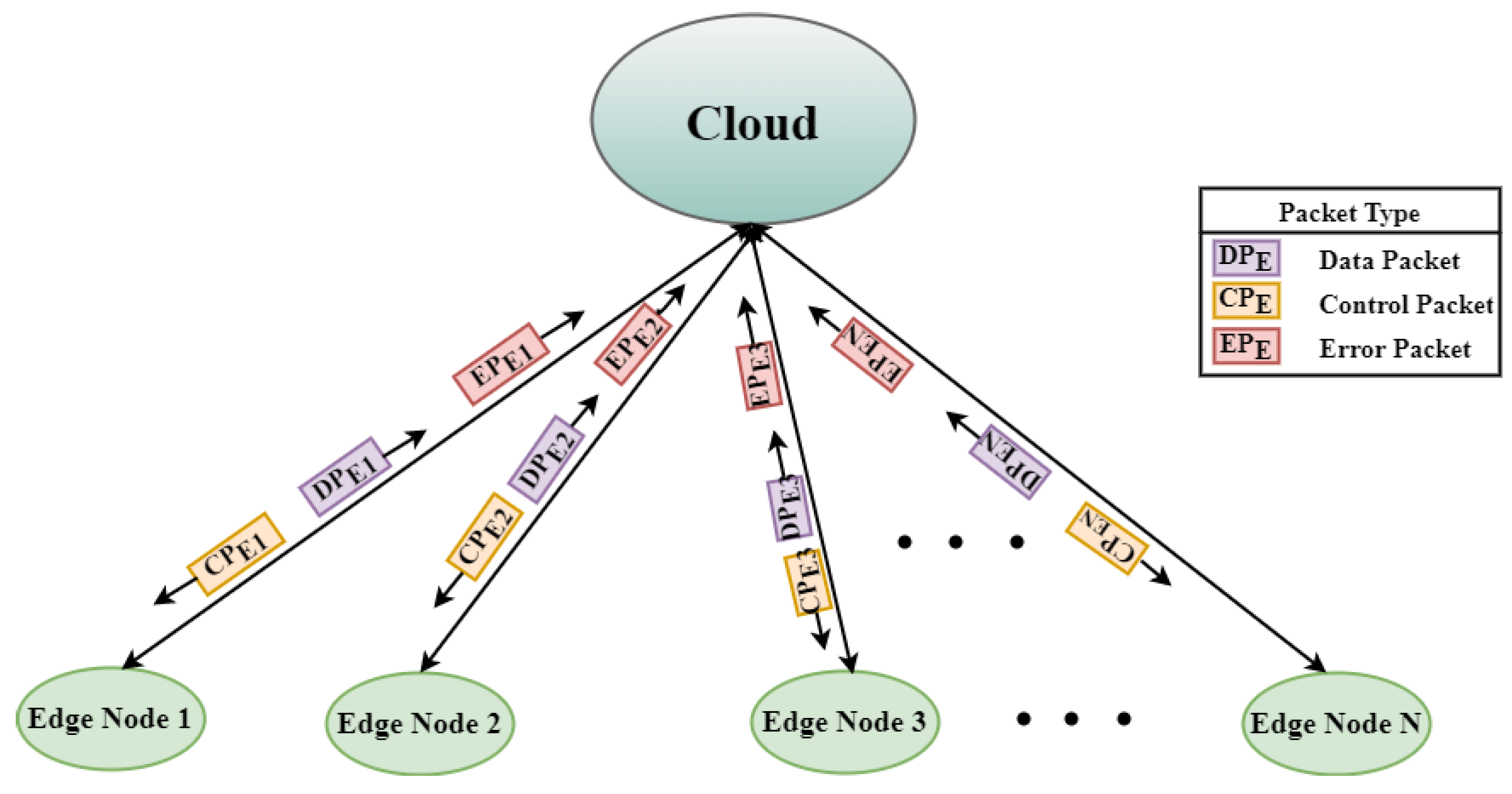

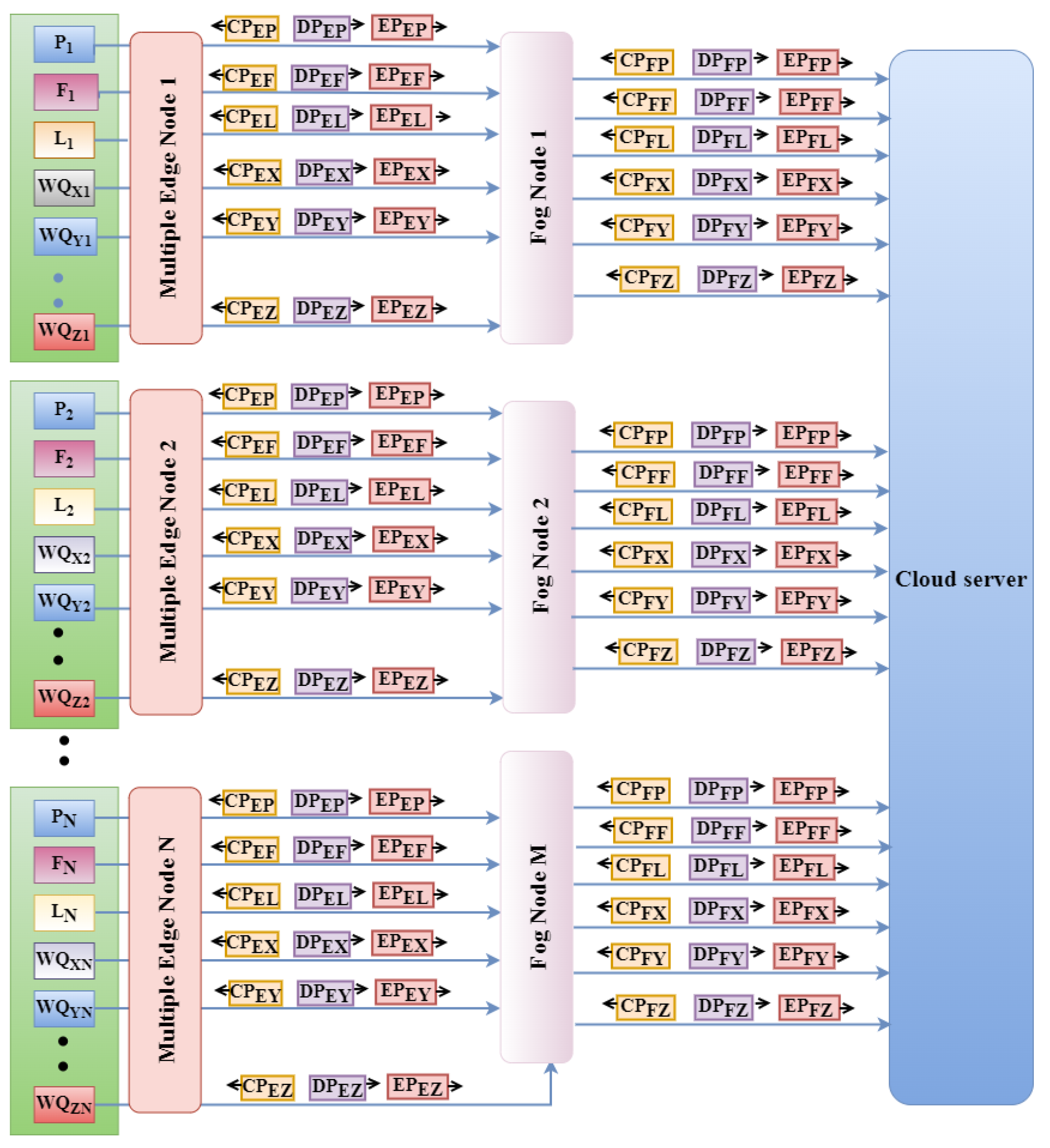
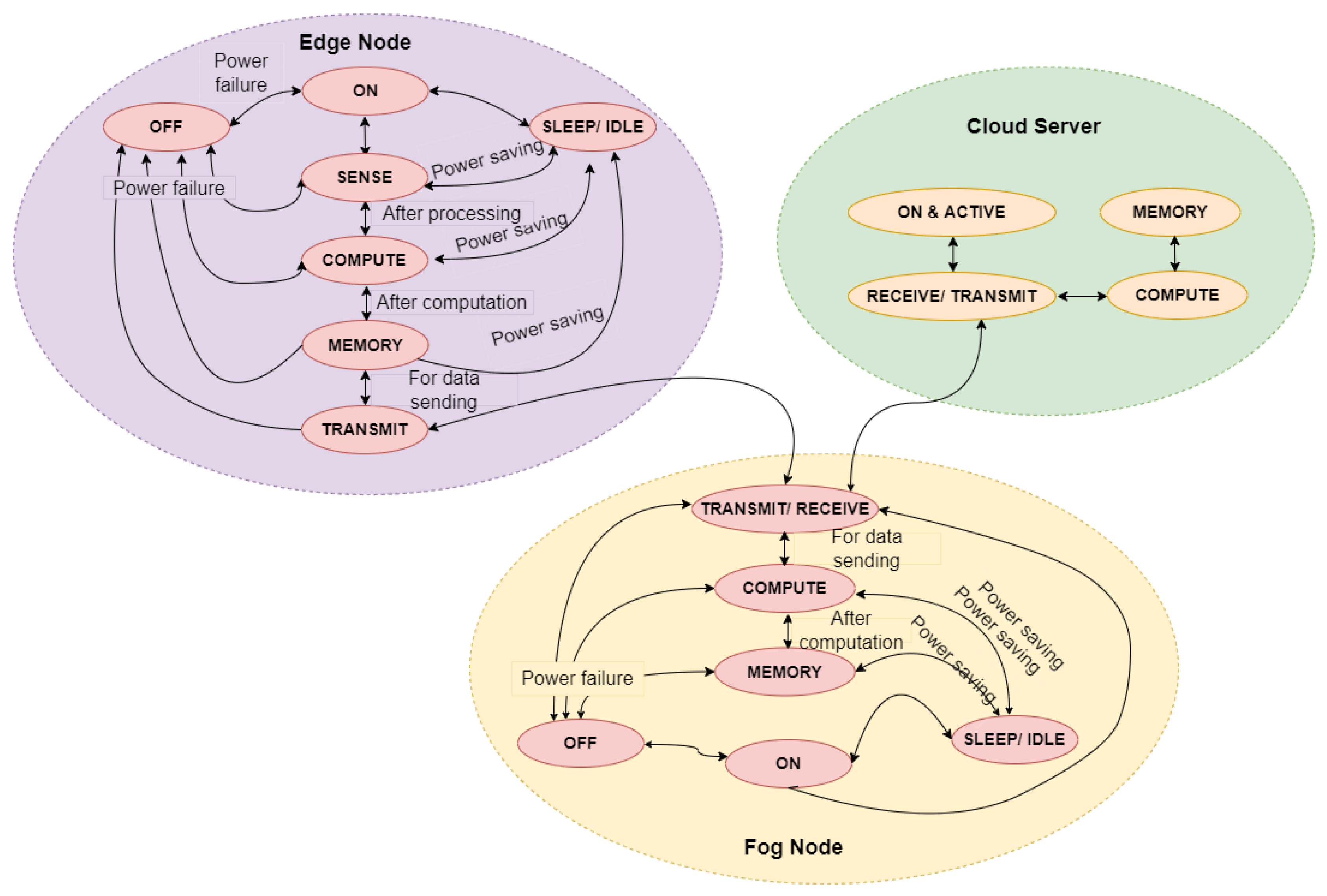



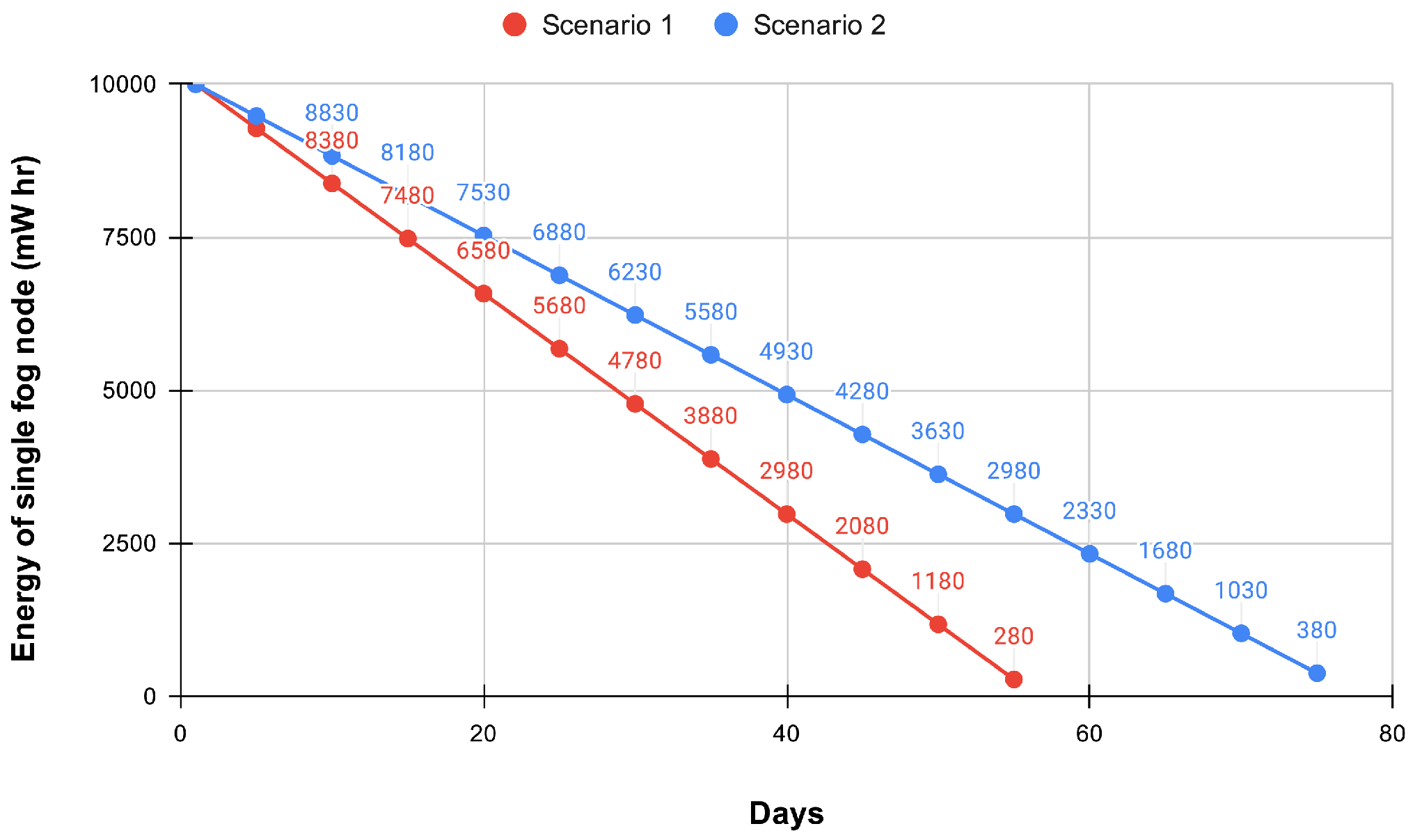

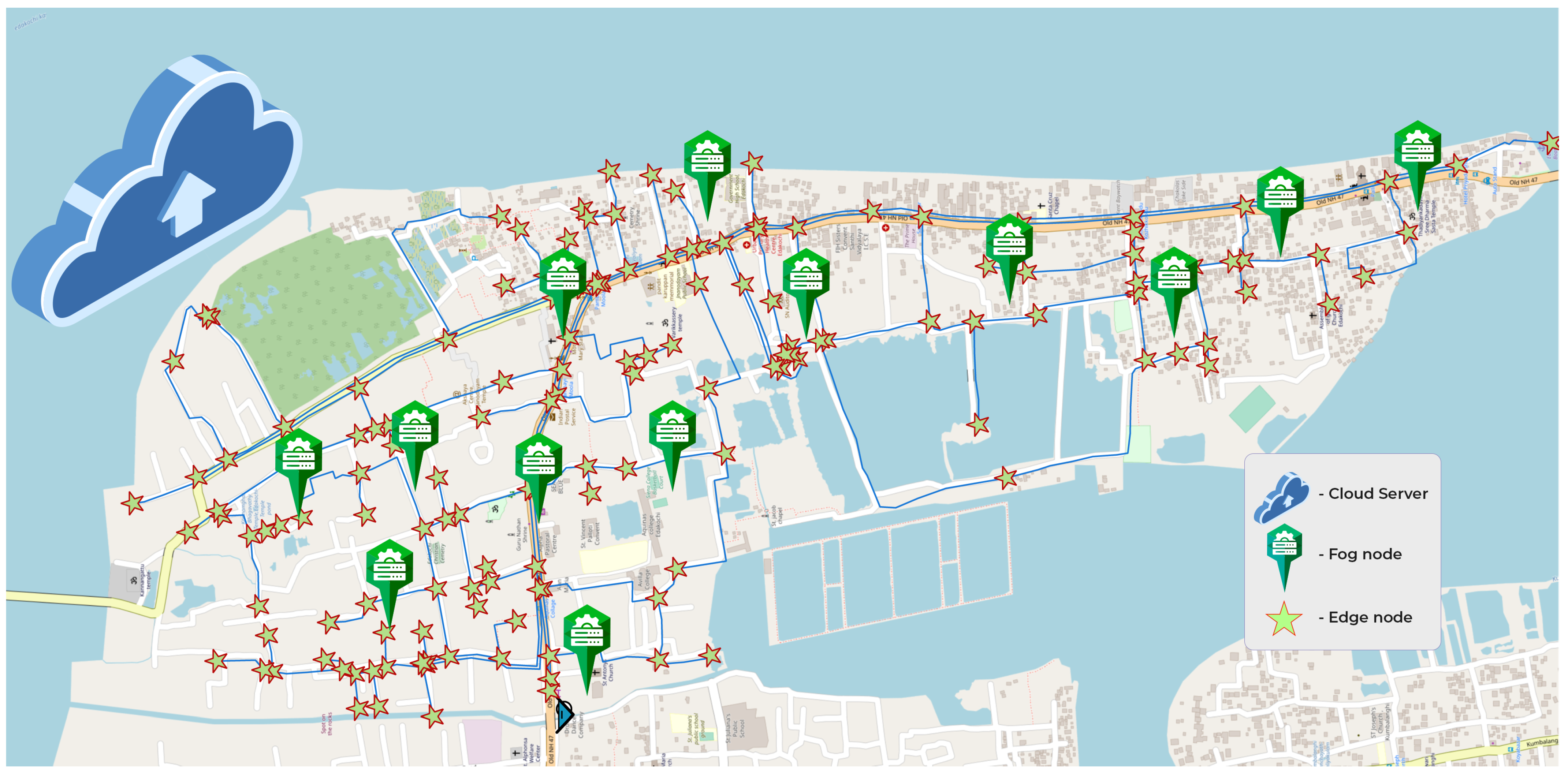
| Sl. No. | Entity | Parameter | Functionality | Issues Faced |
|---|---|---|---|---|
| 1 | Pipe | Flow, velocity, redness coefficient, friction | Total water consumption | Leakage/ breakage |
| 2 | Pressure, friction | Pressure, friction | Indication of minimum required pressure | Leakage/ breakage, theft |
| 3 | Valve | Control | Water control | Control issues |
| 4 | Pump | Pressure Control | Pumping pressure | Dry run or overflow |
| 5 | Water tower or storage structure | Level | Water storage | Overflow or leakage |
| Model Name | Frequency | Application |
|---|---|---|
| HATA | 2500 MHz | The urban land, shrub, open land |
| COMSITE | Up to 2000 MHz | For vegetation cover |
| OKUMURA | 150–1920 MHz | An irregular terrain and environmental clutter |
| LEE | 1–100 MHz | Forest area |
| ICEPACK | 1.5–30 MHz | Through ionosphere |
| ASAPS | 1–45 MHz | Through ionosphere |
| Parameter | Edge Node Values | Channel Values | Fog Node | Cloud Sever Values |
|---|---|---|---|---|
| Operating Frequencies | 2–8 GHz | NA | 2–8 GHz | 2–8 GHz |
| Transmitting Power | 2 mW | NA | 2 mW | 2 mW |
| Antenna gain | 2 dB | NA | 2 dB | 10 dB |
| Height of the antenna | 10 m | NA | 10 m | 10 m |
| Number of available channels | 11 | 13 | 13 | 13 |
| Data rate | 20 Mbps | 20 Mbps | 20 Mbps | 50 Mbps |
| Signal Strength | −27 dB | NA | −20 dB | −15 dB |
| Bandwidth | 5–20 MHz | 5–20 MHz | 5–20 MHz | 100 MHz |
| Sl. No. | Packet Name | Description | Fields Inside Packet | Path | Frequency | Functionality Achieved |
|---|---|---|---|---|---|---|
| 1 | DPEL | Data Packet from LMS of edge node | Water level value, Time | LMS Edge node to ->Fog | 1 min (after the threshold) | To know the real time water level of the tank. To prevent the overflow |
| 2 | CPEL | Control Packet from fog to LMS of edge node | Control messages for sensor nodes (Updates, on/off/sleep) | Fog Server-> Level Monitoring system | Event triggered | To ensure the proper working of sensor nodes Remote management. Time synchronization. |
| 3 | EPEL | Error packet from LMS of edge node | Functional disabilities of sensor nodes | LMS Edge node to ->Fog | Event triggered | To detect the sensing disability of sensors |
| 4 | DPEP | Data Packet from PMS of edge node | Pressure value, Time | PMS Edge node to ->Fog | 1 min (after the threshold) | To know the real time water pressure in the pipeline. |
| 5 | CPEP | Control Packet from fog to PMS of edge node | Control messages for sensor nodes (Updates, on/off/sleep) | Fog-> PMS | Event triggered | To ensure the proper working of sensor nodes Remote management. Time synchronization. |
| 6 | EPEP | Error packet from PMS of edge node | Functional disabilities of sensor nodes | PMS Edge node to ->Fog | Event triggered | To detect the sensing disability of sensors |
| 7 | DPEF | Data Packet from FMS of edge node | Flow rate value, Time | FMS Edge node to ->Fog | 1minutes (after the threshold) | To know the real time water flow rate in the pipeline. |
| 8 | CPEF | Control Packet from fog to FMS of edge node | Control messages for sensor nodes (Updates, on/off/sleep) | Fog Server-> FMS | Event triggered | To ensure the proper working of sensor nodes Remote management. Time synchronization. |
| 9 | EPEF | Error packet from FMS of edge node | Functional disabilities of sensor nodes | FMS Edge node to ->Fog | Event triggered | To detect the sensing disability of sensors |
| 10 | DPEQ | Data Packet from QMS of edge node | Water Quality values, Time | QMS Edge node to ->Fog | 1minutes (after the threshold) | To know the real time water quality parameter values in the pipeline. |
| 11 | CPEQ | Control Packet from fog to QMS of edge node | Control messages for sensor nodes (Updates, on/off/sleep) | Fog-> QMS | Event triggered | To ensure the proper working of sensor nodes Remote management. Time synchronization. |
| 12 | EPEQ | Error packet from QMS of edge node | Functional disabilities of sensor nodes | QMS Edge node to ->Fog | Event triggered | To detect the sensing disability of sensors |
| 13 | DPFF | Data Packets from Fog node | Water flow values, Time | FMS Fog node -> Cloud | 1minutes (after the threshold) | To know the real time water level values in the pipeline. |
| 14 | DPFP | Data Packets from Fog node | Water pressure values, Time | PMS Fog node to ->Cloud | 1minutes (after the threshold) | To know the real time water level values in the pipeline. |
| 15 | DPFL | Data Packet from Level Monitoring system (LMS) | Water level values, Time | LMS Fog node to ->Cloud | 1minutes (after the threshold) | To know the real time water level values in the pipeline. |
| 16 | DPFQ | Data Packet from Quality Monitoring system (QMS) | Water Quality values, Time | QMS Fog node to ->Cloud | 1minutes (after the threshold) | To know the real time water quality parameter values in the pipeline. |
| 17 | EPFP | Error packet from Fog | Functional disabilities of sensor nodes | Fog to ->Cloud | Event triggered | To detect the sensing disability of sensors |
| 18 | EPFF | Error packet from Fog | Functional disabilities of sensor nodes | Fog to ->Cloud | Event triggered | To detect the sensing disability of sensors |
| 19 | EPFL | Error packet from Fog | Functional disabilities of sensor nodes | Fog to ->Cloud | Event triggered | To detect the sensing disability of sensors |
| 20 | EPFQ | Error packet from Fog | Functional disabilities of sensor nodes | Fog to ->Cloud | Event triggered | To detect the sensing disability of sensors |
| 21 | CPFP | Control Packet from Cloud | Control messages for sensor nodes (Updates, on/off/sleep) | Cloud-> Fog | Event triggered | To ensure the proper working of sensor nodes Remote management. Time synchronization. |
| 22 | CPFF | Control Packet from Cloud | Control messages for sensor nodes (Updates, on/off/sleep) | Cloud-> Fog | Event triggered | To ensure the proper working of sensor nodes Remote management. Time synchronization. |
| 23 | CPFL | Control Packet from Cloud | Control messages for sensor nodes (Updates, on/off/sleep) | Cloud-> Fog | Event triggered | To ensure the proper working of sensor nodes Remote management. Time synchronization. |
| 24 | CPFQ | Control Packet from Cloud | Control messages for sensor nodes (Updates, on/off/sleep) | Cloud-> Fog | Event triggered | To ensure the proper working of sensor nodes Remote management. Time synchronization. |
| Operational State | Scenario 1 Power Consumption (mW) | Edge Operating Time Scenario 1 (h) | Fog Operating Time Scenario 1 (h) | Scenario 2 Power Consumption (mW) | Edge Operating Time Scenario 2 (h) | Fog Operating Time Scenario 2 (h) |
|---|---|---|---|---|---|---|
| 0.5 | 24 | 24 | 0.5 | 24 | 24 | |
| 4 | 18 | - | 4 | 12 | - | |
| 2 | 18 | 12 | 2 | 10 | 8 | |
| 12 | 18 | 12 | 12 | 4 | 3 | |
| - | - | - | 0.5 | 12 | 12 | |
| - | - | - | 1 | 8 | 8 | |
| 12 | 18 | 12 | 12 | 4 | 3 |
Disclaimer/Publisher’s Note: The statements, opinions and data contained in all publications are solely those of the individual author(s) and contributor(s) and not of MDPI and/or the editor(s). MDPI and/or the editor(s) disclaim responsibility for any injury to people or property resulting from any ideas, methods, instructions or products referred to in the content. |
© 2024 by the authors. Licensee MDPI, Basel, Switzerland. This article is an open access article distributed under the terms and conditions of the Creative Commons Attribution (CC BY) license (https://creativecommons.org/licenses/by/4.0/).
Share and Cite
Velayudhan, N.K.; S, A.; Devidas, A.R.; Ramesh, M.V. Delay and Energy Efficient Offloading Strategies for an IoT Integrated Water Distribution System in Smart Cities. Smart Cities 2024, 7, 179-207. https://doi.org/10.3390/smartcities7010008
Velayudhan NK, S A, Devidas AR, Ramesh MV. Delay and Energy Efficient Offloading Strategies for an IoT Integrated Water Distribution System in Smart Cities. Smart Cities. 2024; 7(1):179-207. https://doi.org/10.3390/smartcities7010008
Chicago/Turabian StyleVelayudhan, Nibi Kulangara, Aiswarya S, Aryadevi Remanidevi Devidas, and Maneesha Vinodini Ramesh. 2024. "Delay and Energy Efficient Offloading Strategies for an IoT Integrated Water Distribution System in Smart Cities" Smart Cities 7, no. 1: 179-207. https://doi.org/10.3390/smartcities7010008
APA StyleVelayudhan, N. K., S, A., Devidas, A. R., & Ramesh, M. V. (2024). Delay and Energy Efficient Offloading Strategies for an IoT Integrated Water Distribution System in Smart Cities. Smart Cities, 7(1), 179-207. https://doi.org/10.3390/smartcities7010008





